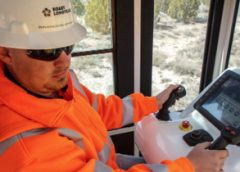Good Operating Practice Is Key to Mitigating the Problem.
By Mark S. Kuhar
Every mining operation has had to deal with damaged drill rods or stalled operations due to drill-hole deviation. While your choice of equipment can help, good operating practice is the most effective way to mitigate the problem.
It is helpful to understand the reason deviation occurs. If drill bits rotate perfectly on a central axis, the direction of advance does not change. However, the mechanics of percussive drilling prevent perfect rotation.
Radial crushing of rock and repeated rotation create a hole larger than the bit diameter. With normal rotation, the bit gears itself against the hole wall. If continuously forced toward the same side of the wall, overbreak occurs and the bit naturally wanders in that direction.
The problem is more pronounced with horizontal holes. Gravity creates sagging in the center of the string, pointing the bit upward and forcing it to rotate off-center. In addition, the weight of the string causes the bit to pivot. Combined with counter-clockwise rotation, the bit is continuously forced to the left side of the hole and tends to wander up and left.
Poor drilling practices and ground conditions compound the problem. Here are the most common factors in hole deviation and general fixes. More specific guidelines can be found in our downloadable presentation.
Good drilling practice, combined with well-chosen equipment and a proper care routine, can diminish hole deviation and help your operation be as productive and cost-effective as possible.
Hole collaring – Hole collaring presents the highest risk of misalignment in the drilling cycle. When collaring, the bit is not supported, so it tends to “skate” across the surface. Uneven rock surfaces cause bending stresses and the potential for the bit to tilt off-center.
Take time to set up accurately and collar correctly.
Feed pressures – Excessive feed pressure causes the string to bend, thus tilting the bit off-center. The downward force of the string weight and feed pressure cause the bit to pivot during rotation. This motion continuously forces the bit to one side of the hole, resulting in deviation.
Use no more feed pressure than necessary.
Ground conditions – In banded ground (successive hard and soft layers), the bit tends to turn into the softer layers. In fractured ground, the bit tends to follow the path of least resistance and follow fissures.
Maintain the correct feed pressure.
Product choice – Certain kinds of rods or bits can help reduce hole deviation. For example, cross bits tend to drill a straighter hole than button bits; however, they can be significantly more expensive.
Choose products only after assessing the opportunity cost of not drilling straight holes as well as the potentially greater and more cost-effective influence of drilling practices.
Product care – Excessive thread wear results in excessive play between mating components and increases the risk of deviation. In addition, dull bits tend to deviate more than sharp bits.
Avoid drilling practices that result in premature thread wear, and regularly check equipment for excessive wear.
The current wave of innovation in surface and underground drilling involves advances in automation that move the industry a big step forward in safety. Electronic controls and other technology developments enable drillers to operate equipment while physically removed from potential sources of danger. While the catalyst for automation is the need to increase safety, automation also results in greater productivity for mining operations.


